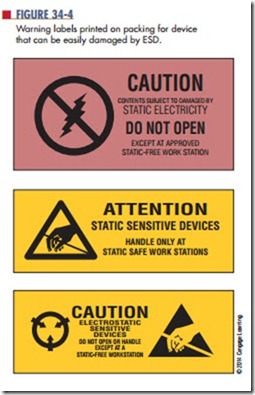handling of Integrated circuits
Integrated circuits are easily damaged with static electricity that is referred to as electrostatic discharge (ESD). ESD is a static discharge and occurs when two positively charged substances are rubbed together or separated, causing a transfer or electrons so that one substance becomes negatively charged. When either substance comes in contact with a conductor, an electrical current flows until it is at the same electrical potential as ground. ESD is commonly experienced more during the winter months when the environment is dry.
Most static discharges that do damage to an integrated circuit will be too weak to feel as they are less than 3000 volts. Most ICs are packaged with warning labels (Figure 34-4) to identify that they are sensitive to damage by static electricity. Others may be shielded in antistatic tubes or carriers. Keep in mind that just
because an IC does not have a symbol or label does not mean it is not ESD sensitive.
Inside an integrated circuit, a static discharge could destroy oxide layers or junctions. These static dis- charges can create an ESD latent defect, causing the device to appear to operate properly even though it is damaged. It has been weakened and failure will result at a later time. There is no method for testing for an ESD latent defect.
The following list will help to minimize damage to an IC through electrostatic discharge:
1. Always check manuals and the IC package materials for ESD warnings and instructions.
2. Wear a grounded wrist strap to discharge any static charge built up on the body.
3. Do not permit the IC to come in contact with clothing or other ungrounded materials that might have a static charge.
4. When handling an IC, minimize physical move- ment such as scuffing feet.
5. Always discharge the package of the IC before removing it. Keep the package grounded until the device is placed in the circuit.
6. Before touching an IC, always touch the surface on which it rests, in order to provide a discharge path.
7. Handle the IC only when it is ready to place in the circuit.
8. When removing and replacing an IC, avoid touching the leads.
9. When working on a circuit containing ICs, do not touch any material that will create a static charge.
Questions
1. What is electrostatic discharge?
2. How does ESD occur?
3. How are integrated circuits identified as sensitive to static electricity?
4. What does a static discharge cause in an integrated circuit?
5. Describe the best way to handle an IC that is identified as sensitive to ESD.
